
|
Sale 122
June 13-16 Pre-Long Beach Auction
| Lot |
Photo |
Description |
Realized |
Lot 1681 |
 |
France. 20 Francs, 1824-A (Paris). Fr-538; KM-712.1. Weight 0.1867 ounce. Louis XVIII. PCGS graded Fine-15. In special PCGS Ship of Gold holder which contains One Pinch of Gold Dust recovered from the S.S. Central America treasure.
Special PCGS number 674151.15/35474683. Estimated Value $500 - UP
View details and enlarged photos
Realized
$2,520 |
|
Lot 1682 |
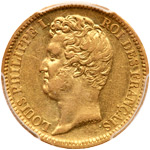 |
France. 20 Francs, 1831-A (Paris). Fr-553a; KM-739.1. Variety with incuse edge lettering. Weight 0.1867 ounce. Louis Philippe I. PCGS graded AU-53. In special PCGS Ship of Gold holder which contains One Pinch of Gold Dust recovered from the S.S. Central America treasure.
Special PCGS number 674252.53/35474712. Estimated Value $500 - UP
In 1831, King Louis-Philippe, who had been brought to power by the July Revolution of the preceding year, showed his resolve in dealing with industrial revolts that threatened to destabilize southwestern France as well as with the ongoing Belgian Revolution. The latter had broken out in 1830 as an attempt to create a largely French-speaking independent kingdom of Belgium distinct from the United Kingdom of the Netherlands, but when Dutch forces crossed into Belgium on 2 August 1831 and won several victories, France unilaterally entered the conflict on the side of Belgium on 9 August. This development potentially threatened the balance of power in Europe, but fortunately Prussia and Russia, the allies of the Netherlands, were unable to offer support at the time. Without allied military assistance, the Dutch could not take on the French army and therefore agreed to a full ceasefire on 12 August and evacuated Belgium by August 20. All of this served to make Louis-Philippe look like a strong, although perhaps somewhat careless, king.
The failing French economy led to the great reduction in pay for the canuts (contracted silk weavers and their apprentices) in the environs of Lyons. In an effort to save their livelihood they enlisted the aid of the regional government in negotiating a fixed price for silkwork with the manufacturers. However, when many manufacturers refused to pay the established price, on 20 November the canuts stopped work and marched to Lyons to air their grievances. After a clash with military forces that left 600 dead and injured, they occupied the city on the next day. Louis-Philippe dispatched an army of 20,000 men to retake Lyons, but warned against executions lest it create outrage against the young July Monarchy. The army entered Lyons without firing a shot, installed a garrison, and abolished the fixed price for silkwork-all of which was attributed to a natural "recognition of the king." However, but realizing the potential of this discontent among the canuts, republicans in Paris immediately dispatched agents to Lyons to create secret societies within the silk labor associations. These would ultimately contribute to the overthrow of the July Monarchy and the creation of the Second French Republic in the February Revolution of 1848.
View details and enlarged photos
Realized
$1,320 |
|
Lot 1683 |
 |
France. 20 Francs, 1839-A (Paris). Fr-560; KM-750.1. Weight 0.1867 ounce. Louis Philippe I. PCGS graded VG-10. In special PCGS Ship of Gold holder which contains One Pinch of Gold Dust recovered from the S.S. Central America treasure.
Special PCGS number 674134.10/35474674. Estimated Value $500 - UP
View details and enlarged photos
Realized
$930 |
|
Lot 1684 |
 |
France. 20 Francs, 1840-A (Paris). Fr-560; KM-750.1. Weight 0.1867 ounce. Louis Philippe I. PCGS graded AU-55. In special PCGS Ship of Gold holder which contains One Pinch of Gold Dust recovered from the S.S. Central America treasure.
Special PCGS number 674267.55/35474726. Estimated Value $500 - UP
Following Napoleon Bonaparte's escape from the island of Elba and abortive return to power in 1815, he was exiled to the small island of St. Helena, where he died and was buried in 1821. Both the British and the restored Louis XVIII refused to permit the repatriation of the Emperor's remains to France on the grounds that it would almost certainly incite political unrest. During the July Revolution of 1830, the revolutionaries included the return of Napoleon 's remains as one of their demands, but this was only undertaken by the July Monarch, Louis-Philippe, a decade later as part of his attempt to regain "all the glories of France." In a remarkable piece of political theater, the body of Napoleon was exhumed on St. Helena and transported to Paris in October 1840 for reburial in a lavish ceremony. The Emperor's remains were subsequently interred in an impressive sarcophagus at the Hôtel des Invalides in Paris.
View details and enlarged photos
Realized
$1,440 |
|
Lot 1685 |
 |
France. 20 Francs, 1840-A (Paris). Fr-560; KM-750.1. Weight 0.1867 ounce. Louis Philippe I. PCGS graded AU-53. In special PCGS Ship of Gold holder which contains One Pinch of Gold Dust recovered from the S.S. Central America treasure.
Special PCGS number 674267.53/35474727. Estimated Value $500 - UP
The so-called retour des cendres ("the return of the ashes") which saw the remains of Napoleon returned to France in October 1840 was intended to reflect his former glory on the increasingly unpopular July Monarchy of Louis-Philippe. However, it also made the king nervous. He ordered the body to be conveyed in an ornate gilded carriage bearing a trophy of flags and the names of Napoleon 's victories and presided over a strictly military ceremony marking its return. While civilians could watch and pay their respects as the funeral cortege passed on its way to Paris, they were prevented from direct participation out of fear of a potential Bonapartist revolutionary outbreak. This exclusion particularly rankled with law and medical students, and the return of Napoleon tended to deepen a general French sense of betrayal by the political elite and increase the longing for the grandeur of First French Empire or even the heady Hundred Days that ended in its destruction. Louis-Philippe was right to be worried. Thanks to the retour des cendres in 1840, the Napoleonic myth continued to grow in France until at last it was strong enough to propel Louis Napoleon Bonaparte to power as Napoleon III, the second Emperor of the French, in 1852.
View details and enlarged photos
Realized
$1,260 |
|
Lot 1686 |
 |
France. 20 Francs, 1855-A (Paris). Fr-573; KM-781.1. Weight 0.1867 ounce. Napoleon III. Bare head right. PCGS graded MS-61. In special PCGS Ship of Gold holder witch contains One Pinch of Gold Dust recovered from the S.S. Central America treasure.
Special PCGS number 674162.61/35474695. Estimated Value $500 - UP
Scarred by decades of unrest, revolution, and conquest, by the mid-nineteenth century Paris was very much in need of a facelift. To this end, in 1854, Napoleon III had himself granted sweeping powers to rebuild the city center to make it a worthy nexus for his Second French Empire. By 1855, he had already made great progress by tearing down hundreds of old buildings and constructing a new railway station, La Gare de Lyon. The building projects of this year also involved the construction of avenues to connect the central points of Paris. This simultaneously did away with many of the cramped streets of the medieval city and established wide avenues that could not be easily barricaded by potential rioters and revolutionaries.
At the same time that Napoleon III was embarking upon the reconstruction of Paris, France continued its military support of Britain in the Crimean War. This conflict broke out in 1854 when Tsar Nicholas I of Russia had attempted to force the crumbling Ottoman Empire to grant him a protectorate over the Christian states in the Balkans and control of the Dardanelles. Following a grueling siege of 337 days, on 11 September 1855, the important Crimean city of Sevastopol was taken from the Russians by the French and British and forced the new Tsar, Alexander II, to come to Paris to negotiate an end to the horrific conflict in 1856. The siege of Sevastopol alone had claimed the lives of 95,000 French soldiers (75,000 from disease) although this number was concealed from the public through Napoleon III's tight censorship of the press. Despite the heavy death toll, French involvement in the war resulted in the warming France's relationship with Britain, which had been icy since the days of the Revolutionary and Napoleon ic Wars, and established a new alliance with Russia. These developments ended the so-called Concert of Europe between Britain, Prussia, Austria and Russia, that had maintained an anti-French status quo since 1815 and introduced the new system of European alliances that would ultimately unleash the nightmare of the First World War in 1914.
View details and enlarged photos
Realized
$1,620 |
|
Lot 1687 |
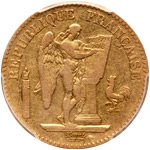 |
France. 20 Francs, 1848-A (Paris). Fr-565; KM-757. Weight 0.1867 ounce. Second Republic. Guardian angel Genius inscribing the Constitution on a tablet. PCGS graded VF-35. In special PCGS Ship of Gold holder which contains One Pinch of Gold Dust recovered from the S.S. Central America treasure.
Special PCGS number 674137.35/35474677. Estimated Value $500 - UP
View details and enlarged photos
Realized
$1,200 |
|
Lot 1688 |
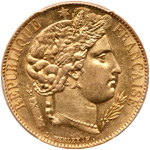 |
France. 20 Francs, 1850-A (Paris). Fr-566; KM-762. Weight 0.1867 ounce. Second Republic. Head of Ceres right. PCGS graded AU-58. In special PCGS Ship of Gold holder which contains One Pinch of Gold Dust recovered from the S.S. Central America treasure.
Special PCGS number 675688.58/35671941. Estimated Value $500 - UP
As part of the February Revolution of 1848, the unpopular Louis-Philippe was forced to abdicate the throne of France and flee to England and the July Monarchy was replaced by a Second French Republic. Unfortunately, only two years later, when this 20-franc piece was struck, the Second Republic was already dying, thanks to its president, Louis Napoleon Bonaparte, who spent much of 1850 developing a crisis in the French Legislative Assembly. Although the elections of that year had brought republicans into the majority, Louis Napoleon supported increasingly conservative and Orléanist policies which led to increasing disaffection with both the conservatives and the seemingly ineffectual republicans.
After the death of Louis-Philippe on 26 August 1850, Louis Napoleon immediately began a tour of France with the aim of garnering support for a new constitution that would allow for his re-election. As he progressed through the country, the glamor of his name inspired cheers of "Vive Napoléon!" particularly with the army. It was clear that the soldiery, who still remembered the glory of the First French Empire of Napoleon Bonaparte, was behind him. Louis Napoleon next galvanized popular support by replacing his largely Orléanist cabinet with obscure men loyal to his person and by denouncing the electoral law of 31 May 1850 (which he had previously assisted in passing) that effectively disenfranchised much of the working class through its residency requirements. By the end of 1850, Louis Napoleon had created the conditions for a perfect storm that would break in January 1851, when the Legislative Assembly refused to accept his proposed amendments to the constitution. Whereas the Assembly was primarily concerned with curbing the president's growing power, this act cast it as an enemy of the people and at last, on 2 December 1851, Louis Napoleon staged a popular coup that overthrew the Second Republic and would subsequently establish the Second French Empire.
View details and enlarged photos
Realized
$1,320 |
|
Lot 1689 |
 |
France. 20 Francs, 1850-A (Paris). Fr-566; KM-762. Weight 0.1867 ounce. Second Republic. Head of Ceres right. PCGS graded AU-55. In special PCGS Ship of Gold holder which contains One Pinch of Gold Dust recovered from the S.S. Central America treasure.
Special PCGS number 674263.55/35474722. Estimated Value $500 - UP
View details and enlarged photos
Realized
$1,140 |
|
Lot 1690 |
 |
France. 10 Francs, 1851-A (Paris). Fr-567; KM-770. Weight 0.0933 ounce. Second Republic. Head of Ceres right. PCGS graded VF-35. In special PCGS Ship of Gold holder which contains One Pinch of Gold Dust recovered from the S.S. Central America treasure.
Special PCGS number 674163.35/35474696. Estimated Value $500 - UP
View details and enlarged photos
Realized
$960 |
|
Lot 1691 |
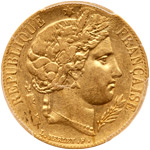 |
France. 20 Francs, 1851-A (Paris). Fr-566; KM-762. Weight 0.1867 ounce. Second Republic. Head of Ceres right. PCGS graded AU-53. In special PCGS Ship of Gold holder which contains One Pinch of Gold Dust recovered from the S.S. Central America treasure.
Special PCGS number 674275.53/35474733. Estimated Value $500 - UP
View details and enlarged photos
Realized
$1,110 |
|
Lot 1692 |
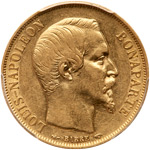 |
France. 20 Francs, 1852-A (Paris). Fr-568; KM-774. Weight 0.1867 ounce. Louis Napoleon Bonaparte, President. Bare head right. One year type. PCGS graded AU-55. In special PCGS Ship of Gold holder which contains One Pinch of Gold Dust recovered from the S.S. Central America treasure.
Special PCGS number 674164.55/35474697. Estimated Value $500 - UP
View details and enlarged photos
Realized
$1,200 |
|
Lot 1693 |
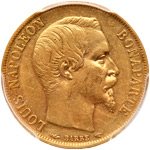 |
France. 20 Francs, 1852-A (Paris). Fr-568; KM-774. Weight 0.1867 ounce. Louis Napoleon Bonaparte, President. Bare head right. One year type. PCGS graded AU-53. In special PCGS Ship of Gold holder which contains One Pinch of Gold Dust recovered from the S.S. Central America treasure.
Special PCGS number 674164.53/35474713. Estimated Value $500 - UP
View details and enlarged photos
Realized
$1,200 |
|
Lot 1694 |
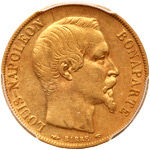 |
France. 20 Francs, 1852-A (Paris). Fr-568; KM-774. Weight 0.1867 ounce. Louis Napoleon Bonaparte, President. Bare head right. One year type. PCGS graded AU-53. In special PCGS Ship of Gold holder which contains One Pinch of Gold Dust recovered from the S.S. Central America treasure.
Special PCGS number 674164.53/35474723. Estimated Value $500 - UP
View details and enlarged photos
Realized
$1,260 |
|
Lot 1695 |
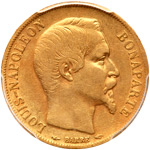 |
France. 20 Francs, 1852-A (Paris). Fr-568; KM-774. Weight 0.1867 ounce. Louis Napoleon Bonaparte, President. Bare head right. One year type. PCGS graded EF-45. In special PCGS Ship of Gold holder which contains One Pinch of Gold Dust recovered from the S.S. Central America treasure.
Special PCGS number 674164.45/35474725. Estimated Value $500 - UP
View details and enlarged photos
Realized
$1,110 |
|
Lot 1696 |
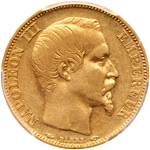 |
France. 20 Francs, 1853-A (Paris). Fr-573; KM-781.1. Weight 0.1867 ounce. Napoleon III. Bare head right. PCGS graded AU-50. In special PCGS Ship of Gold holder which contains One Pinch of Gold Dust recovered from the S.S. Central America treasure.
Special PCGS number 674254.50/35474716. Estimated Value $500 - UP
View details and enlarged photos
Realized
$1,260 |
|
Lot 1697 |
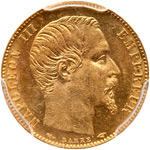 |
France. 5 Francs, 1854-A (Paris). Fr-578; KM-783. Plain edge. Weight 0.0471 ounce. Napoleon III. Bare head right. PCGS graded MS-61. In special PCGS Ship of Gold holder which contains One Pinch of Gold Dust recovered from the S.S. Central America treasure.
Special PCGS number 674165.61/35474698. Estimated Value $500 - UP
Much of 1854 in France was consumed by the concerns of the Crimean War 1853-1856). This conflict had already broken out between Russia and the Ottoman Empire on 16 October 1853, but was stoked by a dispute between France and Russia over the right to serve as protector of the Christian population in the Ottoman Empire. On 28 March 1854, France entered the war alongside Great Britain as an Ottoman ally. Fearing the use of the Russian Siberian flotilla against French and British trading interests in the Pacific, French and British ships attacked to prevent the Russian Empire from dispatching reinforcement from its Siberian fleet, French and British ships made a failed attack on Petropavlovsk in September 1854. More successful was the battle of the Alma in the Crimea on 20 September, which resulted in an Anglo-French victory, but at the high cost of 1,000 French soldiers killed. This was followed in October by the beginning of the siege of Russian forces in Sevastopol and the notorious battle of Balaclava (25 October) that brought the combined French, British, and Ottoman forces to a standstill after the Light Brigade was annihilated in an erroneous charge against Russian guns. However, the doggedly successful defense of Inkerman by the allies on 5 November convinced the Russians that they could not win the war through field battles.
At the same time that French forces were engaged in what was destined to be considered one of the worst managed European conflicts of the nineteenth century, in Paris, the daguerreotype photographer André-Adolphe-Eugène Disdéri was patenting his new process for printing paper carte de visite photographs. His system, patented on 27 November 1824, allowed for the printing of 8 photogaphs on the same sheet. Likewise, in Paris in 1854, Louis Vuitton set up shop as a maker of trunks. His company later developed into a famous fashion house and designer of luxury goods.
View details and enlarged photos
Realized
$1,500 |
|
Lot 1698 |
 |
France. 20 Francs, 1854-A (Paris). Fr-573; KM-781.1. Weight 0.1867 ounce. Napoleon III. Bare head right. PCGS graded AU-55. In special PCGS Ship of Gold holder which contains One Pinch of Gold Dust recovered from the S.S. Central America treasure.
Special PCGS number 674152.55/35474735. Estimated Value $500 - UP
View details and enlarged photos
Realized
$1,380 |
|
Lot 1699 |
 |
France. 20 Francs, 1854-A (Paris). Fr-573; KM-781.1. Weight 0.1867 ounce. Napoleon III. Bare head right. PCGS graded AU-53. In special PCGS Ship of Gold holder which contains One Pinch of Gold Dust recovered from the S.S. Central America treasure.
Special PCGS number 674152.53/35474684. Estimated Value $500 - UP
View details and enlarged photos
Realized
$1,320 |
|
Lot 1700 |
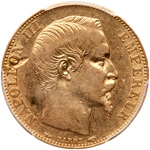 |
France. 20 Francs, 1854-A (Paris). Fr-573; KM-781.1. Weight 0.1867 ounce. Napoleon III. Bare head right. PCGS graded AU-50. In special PCGS Ship of Gold holder which contains One Pinch of Gold Dust recovered from the S.S. Central America treasure.
Special PCGS number 674152.50/35671942. Estimated Value $500 - UP
View details and enlarged photos
Realized
$930 |
|
|
|